List of Greek flags
This is a list of flags used in the modern state of Greece or historically used by Greeks.
| Wikimedia Commons has media related to Flags of Greece. |
National flag
| Flag | Date | Use | Description |
|---|---|---|---|
 | in use since 1822 (as naval ensign), and since 1978 sole national flag. | The current Flag of Greece was adopted by the First National Assembly at Epidaurus in January 1822 as the naval ensign. Between 1822-1978, this flag was used at sea and for foreign service. In 1978, it was established as the sole national flag and also as the war and civil Ensign. | Nine equal horizontal stripes of blue alternating with white. There is a blue canton in the upper hoist-side corner bearing a white cross. |
Presidential Standard
| Flag | Date | Use | Description |
|---|---|---|---|
 | since 1979 | Distinguishing Flag of the President of the Hellenic Republic (President of Greece). Used to show the presence of the President of the Republic (in vehicles, buildings etc.). This flag also used as a Rank flag in the Hellenic Navy's ships mainmast when the President of the Republic is aboard (according to Article 45 of the Constitution the President of the Republic 'is the symbolic head of the Armed Forces' so as Rank flag this flag is regarded as similar to the flag of an Admiral of the Fleet or superior). | A blue square flag bearing at both sides a silver coloured cross with equal arms and a tip formed in the middle of the lower end of the vertical arm. Τhe areas adjoining to the cross have the same colour with flag, the cross bounded with a golden coloured line forming an escutcheon which totally surrounded by two golden coloured laurel branches forming circle, intersecting under the tip in cross. (A form of the Coat of Arms of Greece) The Flag is produced in four sizes (1st 1.70 m (5.58 ft) sides, 2nd 1.10 m (3.61 ft) sides, 3d 0.65 m (2.13 ft) sides and 4th 0.23 m (0.75 ft) sides). |
Military flags
| Flag | Date | Use | Description |
|---|---|---|---|
 | since 1822 | Jack of the Hellenic Navy. | A square flag with a white cross on a blue field. A golden crown was added in the centre during the periods of monarchy (1833–1924 and 1935–1973). |
| | Commissioning pennant (Greek: Επισείων Πολεμικού Πλοίου, i.e., "Warship Pennant") flown by all Hellenic Navy' s Ships and establishments in commission, unless displaced by a senior officer's Rank Flag. | 'Warship pennant, blue coloured, has shape of isosceles triangle elongated, bearing a white cross near the base of the triangle'. The flag has typically base to length (height of triangle) 1 to 20. The cross has arms width 1/5 base length and each arm length 3/5 of base length. The pennant flown on the top of mainmast. | |
 | Army War Flag (regimental colour) (Πολεμική Σημαία Στρατού Ξηράς) | A square flag with a white cross on blue field with image of Saint George. | |
| Air Force War Flag (regimental colour) (Πολεμική Σημαία Πολεμικής Αεροπορίας) | A square flag with a white cross on blue field with image of Archangel Michael. | ||
 | since 1956 | Rank flag of the Prime Minister of Greece aboard Hellenic Navy vessels. | Like the Hellenic Navy jack, with three white rising diagonal stripes in the first quarter. |
 | since 1956 | Rank flag of the Greek Minister of National Defence aboard Hellenic Navy vessels. | Like the Hellenic Navy jack, with three white rising diagonal stripes in the first quarter and three descending stripes in the fourth. |
Regional and municipal flags
| Flag | Date | Use | Description |
|---|---|---|---|
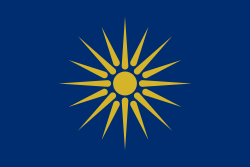 | Late 1980s[1] | Flag of the northern Greek region of Macedonia. Also the flag of the regions of Central, East and West Macedonia. | Blue field with the golden Vergina Sun in the centre. The flag is unofficial but widely recognized in Greece.[2] |
| 1995 | Flag of the Municipality of Athens. | The flag is blue with an inner gold and outer red border, like the flag of the region of Attica. A white Greek cross lies in the middle, charged with a disc with a white border featuring gold olive branches. The blue disc in the center features the head of the goddess Athena. | |
 | 20?? | Flag of the South Aegean. | |
 | Municipal flag of Thessaloniki. | Dark blue with a stylized depiction of the city's main landmark, the White Tower, and an ancient Macedonian coin depicting Alexander the Great. | |
 | Municipal flag of Chania. | The seal of the city of Chania superimposed on the old land flag of Greece, with the words "ΔΗΜΟΣ ΧΑΝΙΩΝ" (Municipality of Chania) on the bottom right and left quadrants. | |
 | Flag of Zakynthos island. | Dark green with an orange depiction of Zakynthos with the island's motto "Freedom needs virtue and courage" (ΘΕΛΕΙ ΑΡΕΤΗ ΚΑΙ TOΛMH Η ΕΛΕΥΘΕΡΙΑ, from Andreas Kalvos' The Lyre). | |
 | Flag of Corfu island. | The flag of Corfu has a dark red/maroon/purple large outer border, a dark gold thin inner border and a very dark blue field with the city seal in the centre in dark gold. The city seal shown an ancient Greek sailing ship. ΔΗΜΟΣ (Municipality) is written above the seal, ΚΕΡΚΥΡΑΙΩΝ (of Corfu), below the seal. The real flag, on which the image shown above is based, has a ratio of 11:19 | |
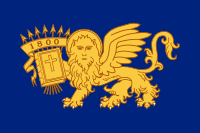 | 1800 | Flag of the Ionian Islands. | Originally the official flag of the Septinsular Republic. Although it is not used for official purposes nowadays, it is widely recognisable as the most important symbol of the unity of these islands. |
 | 1821 | The flag of Kastelorizo, used as an ensign for ships from Kastelorizo during the Greek War of Independence, now a municipal flag. | |
 | 1821 | The flag of Hydra island, used as an ensign for ships from Hydra during the Greek War of Independence, now a municipal flag. | |
 | 1821 | The flag of Psara, used as an ensign for ships from Psara during the Greek War of Independence, now a municipal flag. | White cloth bordered with red with a large red cross and the inscriptions of the motto Eleftheria i Thanatos (Liberty or Death) in capital red letters. The cross is standing on an upside down crescent, symbolizing the Ottoman Empire, flanked on one side by a lance, on the other by an anchor, around which is coiled a serpent eating a bird. |
 | 1821 | The flag of Spetses, used as an ensign for ships from Spetses during the Greek War of Independence, now a municipal flag. | |
 | 20?? | Flag of the North Aegean. | |
 | 20?? | Flag of Thessaly. | |
 | 20?? | Flag of Central Greece. | |
 | 20?? | Flag of Epirus. | |
 | 20?? | Flag of Crete. | |
 | 20?? | Flag of West Greece. |
Historical variants of the national flag
| Flag | Date | Use | Description |
|---|---|---|---|
 | 1770s–1820s | This design appeared in the 1769 uprising, based on older patterns. Used among others by the Kolokotronis family, this flag, with variations, was the most widely used throughout Greece during the initial stages of the 1821 revolution. | A blue cross over a white field. |
 | 1822–1828 | First flag of the Greek Merchant Navy, adopted in January 1822. In 1828 it was discontinued, as it was decided that the cross-and-stripes naval flag (today's national flag) should be flown by both military and merchant ships. | Blue flag with an inverse state flag on the canton (Blue cross on white field). |
.svg.png) | 1822 - 1970 1975 - 1978 | In January 1822, the First National Assembly at Epidaurus adopted this design to replace the multitude of local revolutionary flags then in use. Since 1828, this flag was flown inside the country, while the current flag was flown on naval vessels and abroad. | White cross on a blue field. During the periods of monarchy (1833–1924 and 1935–1973), a golden crown was often added in the centre of official flags (see examples below). |
.svg.png) | 1833–1862 | State and War flag on land during the reign of King Otto. | The flag consists of the plain cross version of the national flag, with the Bavarian arms of the Wittelsbach dynasty superimposed in the center of the cross, topped by a crown. The blue color is of a lighter shade than usual today. |
.svg.png) | 1833–1862 | State and War ensign at sea during the reign of King Otto. | The flag consists of the naval version of the national flag, with the Bavarian arms of the Wittelsbach dynasty superimposed in the center of the cross, topped by a golden royal crown superimposed in the canton. The blue color is of a lighter shade than usual today. |
 | 1863–1913 | The first Royal Standard of Greece.[3][4] | Similar to the Danish Flag, with Nordic Cross and the Coat of Arms of House of Glücksburg. |
.svg.png) | 1913–1922 | Royal Standard of the King, adopted in 1913. | Like the Navy jack, but in a light blue field with the Arms of King Constantine I at the center. Behind the arms are two crossed Field Marshal's batons. |
.svg.png) | 1916–1922 | Standard used by the Crown Prince, adopted in 1916. | Like the Navy jack, but in a light blue field. In the first and third quarter is a royal crown. |
.svg.png) | 1863–1913 | Standard used by King George I of Greece. | The flag consists of the plain cross version of the national flag, with a Royal Coat of Arms of Greece superimposed in the center of the cross. |
.svg.png) | 1914-1924 | The flag of the Minister of the Navy. | |
.svg.png) | 1935–1974 | Royal Standard of the King, adopted in 1935. | Like the Navy jack, with the Royal Family arms in the centre and four crowns in the quarters. |
.svg.png) | 1935–1974 | Standard of the Crown Prince, adopted in 1935. | Like the Navy jack, with the Greek Royal Family arms in the centre and one crown in the first quarter. |
.svg.png) | 1935–1974 | Standard used by the Greek Royal Family, adopted in 1935. | Like the Navy jack, with the Greek Royal Family arms in the centre but no crown. |
 | 1935–1970 | Royal version of the State Flag during the Kingdom of Greece. | The flag consists of the plain cross version of the national flag, with a detailed golden royal crown superimposed in the center of the cross. The field is bordered by a gold fringe. |
 | 1863 - 1924 1935 - 1970 | State and War flag on land during the Greek Royal Family in the Kingdom of Greece. | The flag consists of the plain cross version of the national flag, with a golden royal crown superimposed in the center of the cross. |
 | 1863 - 1924 1935 - 1970 | Jack of the Royal Hellenic Navy. | A square flag with a white cross on a blue field with the Hellenic Royal Crown in the centre. The crown was added during the periods of monarchy (1833–1924 and 1935–1973). |
 | 1863 - 1924 1935 - 1970 | State and War ensign at sea during the Greek Royal Family in the Kingdom of Greece. | The flag consists of the naval version of the national flag, with a golden royal crown superimposed in the center of the cross in the canton. |
 | Ensign of the Royal Hellenic Air Force until 1973. | A white cross on a blue field with the roundel of the Hellenic Air Force in the centre, the royal crown in a circle on the canton. | |
.svg.png) | Ensign of the Hellenic Air Force (1973–1978) and Greek Civil Air Ensign, until 1978. | A white cross on a blue field with the roundel of the Hellenic Air Force in the centre. | |
 | 1964–1980 | Hellenic Coast Guard service flag. | The naval ensign with two golden anchors, crossed, in the centre of the cross. |
.svg.png) | 1970–1975 | National flag adopted by the Colonels' regime. | The sea flag, in ratio 7:12 and in very dark shade of blue (dark "midnight blue"). The old "land" version was restored as national flag in 1975. |
Current and historical variants used outside Greece
| Flag | Date | Use | Description |
|---|---|---|---|
.svg.png) | 1834–1912 | Flag of the autonomous Principality of Samos, tributary to the Ottoman Empire. | The flag consists of the plain cross version of the Greek national flag, with the upper half field in the red of the Ottoman flag. |
 | 1898–1908 | Flag of the autonomous Cretan State. | The flag consists of the plain cross version of the Greek national flag, with the canton in red with a white five-pointed star, symbolizing Ottoman suzerainty. It was not popular during its period of official use, as Cretans wanted union with Greece, and was de facto abolished following the island's unilateral proclamation of union with Greece in September 1908. |
 | 1866 | Flag used in the Arkadi Monastery by Christian Cretans supporting union with Greece, during the Great Cretan Revolt of 1866–1869. | The flag consists of the plain cross version of the Greek national flag, featuring the initials of the motto Κρήτη, Ένωσις, Ελευθερία ή Θάνατος ("Crete, Enosis, Freedom or Death"), and the cross with the inscription IΣ ΧΣ ΝΙΚΑ ("Jesus Christ Conquers"). |
 | 1912 | Flag of the Free State of Ikaria. | |
| | 1914 | Flag of the Autonomous Republic of Northern Epirus. | |
 | 1917–1922 | Flag of the Republic of Pontus. | |
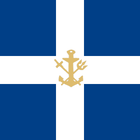 | since 1964 | Jack of the Cyprus Navy. | A square flag with a white cross on a blue field, with a crossed anchor, trident and cross in gold superimposed. |
Historical Greek flags
| Flag | Date | Use | Description |
|---|---|---|---|
 | ca. 1350 | Flag of Constantinople, attested in the 14th-century Spanish atlas Conosçimiento de todos los reynos | The flag features the red St. George's cross (possibly associated with the Genoese colony of Galata) and the dynastic arms of the Palaeologi, the tetragrammatic cross with the four betas (commonly, as here, depicted in the form of stylized fire-steles). |
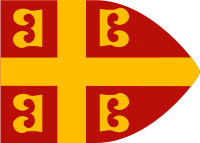 | Also in Spanish atlas Conoscimento de todos los reinos the well-documented "plain" tetragrammatic cross (a symbol of the Palaiologos dynasty) flag is presented as the flag "of the real Greece and Empire of the Greeks (la vera Grecia e el imperio de los griegos)" (not being clear whether this implies usage of the quartered flag only in Constantinople). | Golden cross with four betas on red field. | |
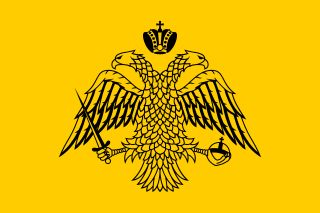 | Although it is the emblem most commonly associated with the Byzantine Empire, the double-headed eagle has not been documented in any historical banner or flag (most probably it remained a personal and/or dynasty symbol of Byzantine Emperors). This also serves as the flag of the Greek Orthodox Church. | A black double eagle on yellow (originally gold) field. | |
 | 1431–1619 | The Greek sipahi cavalry units serving with the Turkish army were allowed to use this flag during the first centuries of Ottoman rule, when within the territory of Epirus and the Peloponnese. Similar flags were used during the Greek Revolution. | A blue cross over a white field, with an image of St. George slaying the dragon in the middle. |
 | This flag, the so-called "Græco-Ottoman" ensign (Γραικοθωμανική παντιέρα), was allowed for use by Greek merchant ships during the latter stages of Ottoman rule. | The flag consists of three horizontal stripes in the colours red (for the Ottoman Empire), blue (for the Greeks) and red (see article on Ottoman flags). | |
 | The flag of the Filiki Eteria. | ||
 | 1821–1825 | The flag of the Areopagus of Eastern Continental Greece, a regional administration during the Greek Revolution. | The flag consists of three vertical stripes in the colours green, white and black. The cross stands for Orthodox Christianity, the flaming heart for the will to fight for independence, and the anchor for the steadfastness of purpose. |
 | 1821 | Flag of the Sacred Band. | |
 | 1821 | Used by Athanasios Diakos and his irregulars during the Greek War of Independence. | The figure of St. George slaying the dragon, with the motto Ελευθερία ή θάνατος (Freedom or Death). |
.svg.png) | 1821 | The first Greek revolutionary flag, raised at the beginning of the Greek War of Independence by Andreas Londos. | A black Latin cross in the center of a red field. |
.svg.png) | 1821 | Used by Alexander Ypsilantis. | |
 | 1821 | Used by Anthimos Gazis and his irregulars from Thessaly during the Greek War of Independence. | |
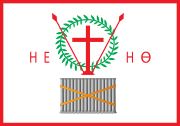 | 1821 | Flag of the Military-Political System of Samos during the Greek War of Independence. | |
.svg.png) | 1821 | Flag of the revolutionaries from Chalkidiki during the Greek War of Independence. | |
.svg.png) | 1821 | The flag of the fighters of the autonomous Mani Peninsula. | A blue Greek cross on white background, with the words "Victory or Death" and the ancient Spartan motto "With it or upon it" in gold. |
 | 1800–1807 | Flag of the Septinsular Republic, a self-governing state comprising the Ionian Islands, under joint Russian and Ottoman suzerainty. | The flag depicts the "Lion of St. Mark", the symbol of the Republic of Venice, under whose rule the Ionian Islands were until 1797. The lion holds seven bundled arrows, representing the unity of the seven islands, with the Bible superimposed on them. |
 | 1817–1864 | Flag of the United States of the Ionian Islands, a British protectorate from 1815 until its cession to Greece in 1864. | The flag is a variation of the British colonial Blue Ensign, with red bordering. It is defaced with the islands' emblem, a variant of the Venetian "Lion of St. Mark" holding seven bundled arrows, representing the unity of the seven Ionian Islands, with the Bible superimposed on them. |
.svg.png) | 1834–1912 | Princely flag of the autonomous Principality of Samos, tributary to the Ottoman Empire. | The flag consists of a white triangle on blue background, bearing a red Greek cross in the centre. |
See also
References
- ↑ Znamierowski, Alfred (2010). The World Encyclopedia of Flags. Anness Publishings. ISBN 978-1-84476-895-0.
- ↑ Eleni Kokkonis-Lambropoulos & Katerina Korres-Zografos (1997). Greek flags, arms and insignia (Ελληνικές Σημαίες, Σήματα-Εμβλήματα) (in Greek). E. Kokkonis-G. Tsiveriotis. ISBN 960-7795-01-6.
- ↑ FLAGS AND SIGNALS OF ALL NATIONS by Hounsell Brothers c.1870 http://www.life.com/image/50700092
- ↑ Greek National Historical Museum http://www.nhmuseum.gr/details2.php?lang=1&wh=1&the1id=1&the2id=7&the3id=69&theid=69&open1=1&open2=7&open3=69&thepid=185&lang=2
- ↑ Ottfried Neubecker, Heraldry — Sources, Symbols and Meaning, pp.106, Tiger Books International (Twickenham), 1997.
External links
This article is issued from Wikipedia - version of the 9/28/2016. The text is available under the Creative Commons Attribution/Share Alike but additional terms may apply for the media files.